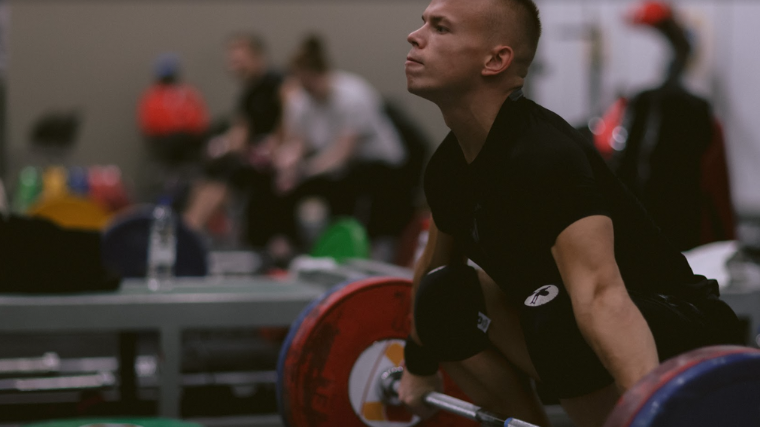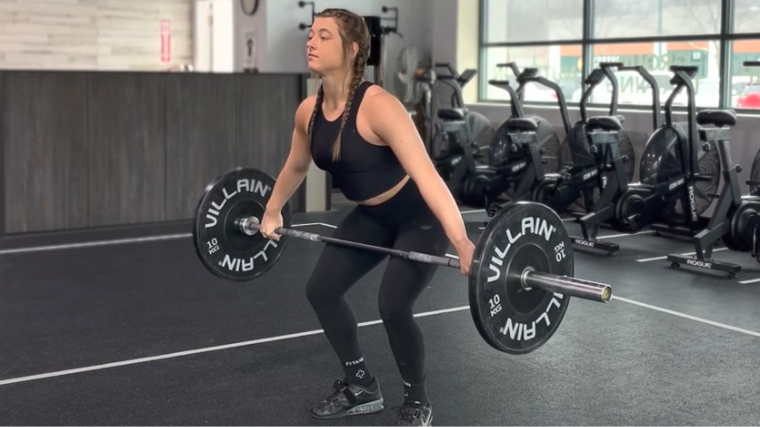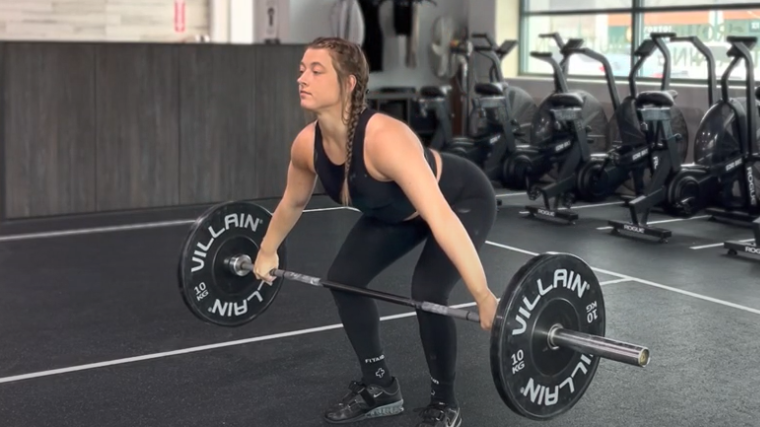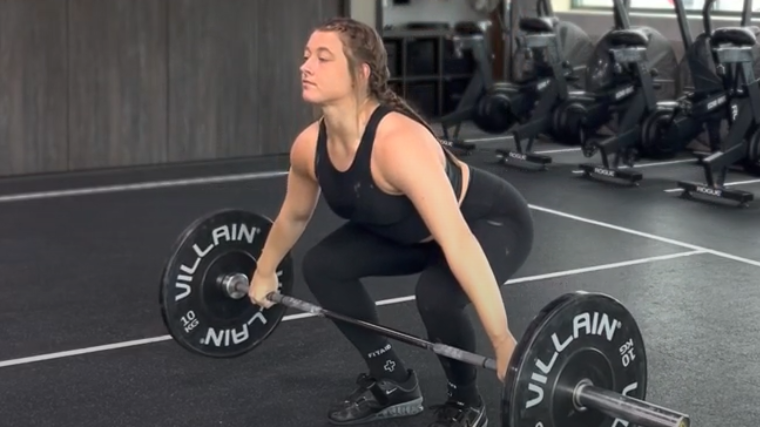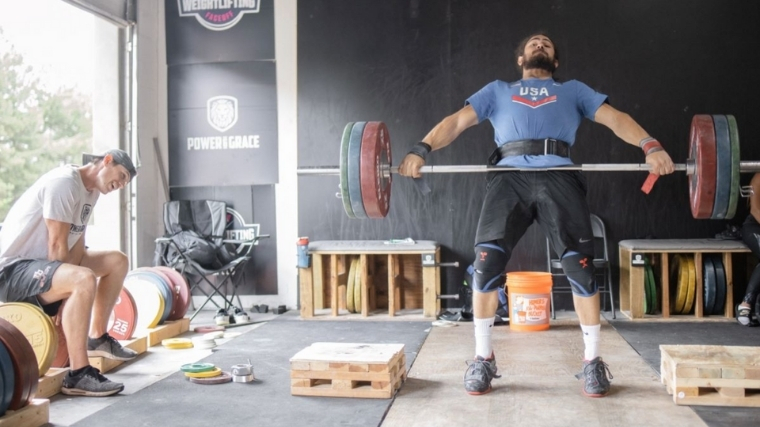For a sport that tests only two competitive movements, Olympic lifting training involves a surprisingly broad array of different accessory and supplemental exercises. Weightlifters work to boost their strength in the snatch and clean & jerk by practicing those lifts specifically, but also rely on other tools to become stronger, faster, and more precise in their sport.
If you’ve found yourself interested in the world of weightlifting, you’ve probably run across “hang” exercises. Weightlifters spend a tremendous amount of time working from the hang both as first-time learners and full-time veteran athletes.
Here is everything you need to know about the hang position and how to utilize it to become freakishly fast, uncommonly strong, and downright deadly with the barbell.
Editor’s Note: The content on BarBend is meant to be informative in nature, but it should not be taken as medical advice. When starting a new training regimen and/or diet, it is always a good idea to consult with a trusted medical professional. We are not a medical resource. The opinions and articles on this site are not intended for use as diagnosis, prevention, and/or treatment of health problems. They are not substitutes for consulting a qualified medical professional.
What Is the Hang Position in Weightlifting?
The hang position is quite straightforward. If you’re working from the hang, the exercise or drill you’re performing begins with the barbell suspended in the air, rather than motionless on the floor. Colloquially, you stand upright with the bar against your hips or thighs, and then let it hang down to a specific position.
Note that where you “hang” to — meaning, the exact point at which you suspend the barbell before beginning upward movement — depends greatly on your specific training needs and the purpose of the movement itself.
Most weightlifting coaches and athletes divide the hang position into three broad categories, each with their own unique benefits.
[RELATED: Best Barbells]
High Hang
If you hear a weightlifter say they’re working from the high hang, it means that they’re letting the barbell fall to a mid or high-thigh position. The athlete begins lifting the bar upward while it is already “high” on their legs.
High hang work is forceful and abrupt. With only a few inches of eccentric motion, the athlete is forced to swap from slowly lowering the bar to driving it upward in the blink of an eye. This forces the weightlifter to dive underneath and catch the bar as fast as possible, since they have less time to impart upward momentum onto it.
Weightlifters use the high hang to improve their speed under the barbell and force development patterns, usually with relatively light weights.
Mid Hang
The mid hang position falls around knee-level. This is also generally considered to be the default hang height — if you’re running a weightlifting workout plan and you see hang work with an unspecified height, you can usually assume you’re meant to lower the bar until it hangs just in front of your kneecaps or slightly above.
The knee-hang position provides all the quintessential benefits of hang work. Lowering the barbell from a standing position down to your knee gives you plenty of time to practice your posture and maintain a rigid posterior chain.
A mid-hang lift also allows the weightlifter to express the most strength of any hang height. Weightlifters can often lift more from a mid-hang position than they can from the floor, particularly if they have strong backs and hips relative to their legs.
Low Hang
Any time you see a weightlifter guiding their barbell downward until it passes their knees but doesn’t come in contact with the ground, they’re working from the low hang. While some athletes are stronger in certain positions than others, low hang lifts are extremely taxing overall due to the extended range of motion.
You can use low hang work to reinforce proper pulling posture. With the barbell suspended just above the ground, you’ll find that you closely replicate the starting position of a standard snatch or clean.
However, holding the barbell aloft provides you with an enormous amount of tactile feedback — it helps you identify weaknesses in your isometric strength or force generation. Low hang lifts are a great way to help the weightlifter “find their legs” if they habitually rely on their back too much.
A sequence of several low-hang lifts are called “floating” snatches, cleans, or pulls. You’re meant to hang as low as possible until the plates barely touch the ground, but keep the bar “floating” in the air the whole time.
Benefits of Hang Lifts
Hang work may be one of many tools weightlifters use to sharpen their techniques, but it’s among the most common — for good reason. If you train as a weightlifter full-time, you’ll log plenty of hours of hang work, especially in the off-season when not preparing for an imminent competition.
It’s a Great Teaching Tool
On your first day of Olympic lifting practice, your coach or instructor — which you should have, if you’re serious about getting into the sport — will likely have you begin with some variation of a hang movement.
Hang training tends to be more intuitive for beginners than trying to learn the snatch or clean & jerk from the floor. Standard resistance training contains plenty of eccentric lowering phases, so teaching the weightlifting movements from a hang can help bridge the gap for learners.
It’s also a way of breaking up a large, complex exercise with many moving parts into something smaller and more digestible. There’s plenty to keep track of when you’re snatching from the floor; performing a snatch from a hang instead lets you compartmentalize things and work on one aspect of the lift at a time.
Helps You Address Weak Points
Weightlifters also use hang exercises to isolate certain areas of their pull that may need some direct attention. For example, if you find yourself struggling to drop under the barbell quickly after you extend your legs, working from the high hang can allow you to focus solely on improving that quality.
Hang exercises also remove areas of your pull that may create more problems down the line. If, when snatching or cleaning from the floor, you make a technical error that creates a larger problem later in the lift, working from the hang instead may be wise.
An error in the beginning of the lift may needlessly affect your overall performance, which is a great reason to implement some hang training as a temporary workaround.
Strengthens Your Back
Olympic lifters have some of the strongest backs in the strength training game. A large portion of that credit is owed to how much time they spend working the hang. Hang lifts are, essentially, a posterior chain exercise, at least during the lowering phase when you hinge at the hips.
When you perform a snatch or clean from the floor, your backside is loaded isometrically the whole way through. The tissues in your hamstrings, glutes, and lower back don’t lengthen under load: Some literature has shown that eccentric tension is integral for both muscle growth and strength gains. (1)
So, working from the hang offers a unique physiological stimulus that standard floor-based lifting doesn’t provide to the same degree.
May Help You Work Around an Injury
If you’ve been cleared by a medical professional to continue your weightlifting training, you may find yourself utilizing plenty of hang variations while you rehab whatever is bugging you. Weightlifters who are currently nursing injuries that only affect certain postures will regularly substitute hang work in that avoids the affected range of motion.
For example, if you have a lower back or knee injury that flares up when snatching or cleaning from the floor, you may find that a high hang power snatch or clean is a suitable workaround.
Hang variations are in no way a treatment for sports injuries, but they do offer a great deal of flexibility for the weightlifter who wants to maintain as much fitness as possible while they address the issue directly.
When to Use Hang Lifts in Weightlifting
When it comes to optimizing your training as an Olympic lifter, knowing when (and when not) to implement a variation of the two primary lifts is critical. You shouldn’t just chuck hang work into your program haphazardly.
As a Beginner
If you’re trying to teach yourself how to snatch or clean, or are working under the tutelage of a coach, you should probably be doing a lot of hang work. Hang lifts are very appropriate for beginners due to how they compartmentalize an otherwise-complex movement.
As a beginner, try performing a series of hang snatches and cleans from various heights. You can start with a high hang lift, then a hang to knee-level, and then finally a hang lift from below the knee. This is called a “three-position” complex, and is a core concept in early weightlifting instruction.
During a Complex
In weightlifting, a “complex” refers to a series of movements performed back-to-back with no rest, like a superset. But, instead of the goal being to work two opposing muscles, complexes are intended to reinforce good technical habits through sequential execution.
A weightlifting complex must contain at least two different movements — think of a standard snatch from the floor, followed immediately by a hang snatch at knee level. In both movements, you perform your second pull from knee-level to extension, which reinforces good habits.
Once you know where your weaknesses are and which weightlifting accessories target them well, you can build your own complexes. A weightlifter who struggles to put enough height on their barbell during the clean & jerk might do a complex consisting of two hang power cleans and then a hang clean & jerk to encourage maximum power output.
To Save Your Legs
In the weeks leading up to a competition, weightlifters will often adjust their training to preserve as much of their maximal strength as possible, particularly in their legs. As such, it’s fairly common to see high-level Olympic lifters perform some pretty heavy hang lifts in the training hall.
Working from the hang allows you to go pretty heavy so you’re mentally prepared to max out on the platform, but it requires a bit less dynamic effort from your quads since you aren’t lifting from the floor.
So, if you find that your legs are fried from a hard bout of training, or want to preserve as much explosive power as you can, switching to the hang can help in the short term.
Hang vs. Block Lifts in Weightlifting
It’s worth taking a moment to address how hang training compares to using lifting blocks. While powerlifters occasionally pull their deadlifts from an elevated position via low blocks, weightlifters regularly make “block work” a huge component of their general training.
Blocks — which are, quite literally, large foam or wood cubes upon which a loaded barbell can rest — serve mostly the same purpose as lifting from the hang. They’re meant to suspend the bar at a particular height so a weightlifter can address technical limitations or work around an injury, in some cases.
However, the two share one significant difference. To pull from knee height during a hang, you have to lower the barbell down to that height yourself. You can rest the barbell at knee level with a pair of blocks and pull from there instead.
Blocks let you take your time with your setup and posture before initiating any movement. They also remove the eccentric loading component, which makes them great for practicing the snatch and clean without accumulating too much muscular fatigue. Each has a place in a well-rounded program; it all depends on context.
Best Hang Variations in Weightlifting
If you’re on the hunt for the best hang lifts to include in your own weightlifting workouts, you’re in luck. These exercises are staples of hang training and should carry over quite well to your regular snatch or clean & jerk. Note that they’re far from the only ways to utilize the hang position; these movements or drills just work exceptionally well from the hang.
High Hang Snatch
Many weightlifters struggle with achieving a forceful, vertical extension when they snatch. If this is you, incorporating some high hang work might remedy the issue once and for all.
The high hang snatch takes almost everything else out of the equation. You have only a couple of inches of pulling to do before the bar flies upward. To make the lift successfully, you absolutely must extend your legs and hips in the correct fashion.
Hang Muscle Snatch
Certain hang variations are just as useful as technical primers as they are as full-fledged accessory exercises. The hang muscle snatch is one such movement — it’s got a straightforward technique, but hammers your technical execution hard.
Hang muscle snatches are great for reminding yourself what proper sequencing feels like. When you snatch, your legs should extend fully before your arms do any work to pull on the bar. The hang muscle snatch reinforces this relationship.
Floating Clean Pull
You can use an exercise like the floating (or low hang) clean pull as both a strength movement and a teaching tool. Multiple low hang lifts strung together are great at reminding you where you should feel tension in your body.
By not letting the plates touch the floor, you’re forced to focus on continuously generating power through your legs, rather than yanking abruptly with your back. Otherwise, you simply won’t achieve any meaningful bar elevation at the top. Furthermore, repeated low hang pulls will remind you to keep your arms loose and relaxed.
Hang Tight
In many ways, the sport of weightlifting is like an iceberg. On the surface are only two movements, each with very intricate techniques but simple criteria for success; get the barbell over your head.
Beneath the snatch and clean & jerk, though, there’s a whole world of unique training tools and technical processes that help develop an athlete into a successful weightlifter. Hang lifts are the bread and butter of a weightlifter’s accessory training. Once you get the hang of them, you’ll see why.
References
- Hody, S., Croisier, J. L., Bury, T., Rogister, B., & Leprince, P. (2019). Eccentric Muscle Contractions: Risks and Benefits. Frontiers in physiology, 10, 536.
Featured Image: William Johnson / @barbellstories
